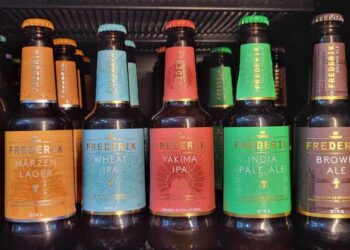The Story of Bass: the rise and demise of a brewing great. Harry White, Amberley Books, £15.99
The story of Bass is a remarkable one. Based in the small Midlands town of Burton-on-Trent, it grew from humble beginnings to become by the end of the 19th century the biggest brewer in the world until it was dwarfed by commercial lager brewing in Europe and the United States.
Harry White worked for Bass from the mid-1970s and became director of quality in 1989. When Bass left brewing in 2000, he moved to its successor Molson Coors until he retired in 2007. He is therefore well placed to recount the history of the company but the end result is disappointingly thin on detail and information.
He refers in passing to the characteristics of Burton water without explaining that the mineral-rich springs in the Trent Valley played a critical role in developing the first pale ales. The Burton Union system of fermentation is mentioned only in a caption to a photograph of troughs in the fermenting room. Again there is no explanation of how the unions helped develop the unique flavour and aroma of Burton pale beers.
He mentions “technical improvements” in the brewing process in the 19th century. That is scant coverage for a period that saw major upheavals in the way beer was made. Steel and copper vessels replaced wood and retained heat better. Improved malt was made on a vast scale while yeast was, for the first time, scientifically understood, enabling beer quality to improve immeasurably.
Refrigeration was grasped as keenly in Burton as in the emerging lager breweries of central Europe. The ability to control the temperatures of all aspects of the brewing process, fermentation in particular, meant that brewing ceased to be a seasonal activity confined to the cooler months and could take place all year round. This had a profound impact on the industry and enabled brewers to grow in size and commercial success, but this is overlooked in the book.
The author gives the impression Bass concentrated on building sales in Britain whereas in fact it was an exporter on a vast scale. Not only was its India Pale Ale sent to the sub-continent but further afield to Australasia, North America and to such unlikely countries as France. This is seen in Manet’s famous painting A Bar at the Folies Bergère that shows a bottle of Bass with the famous red triangle trademark on the label.
A decline in sales of Bass beers at the end of the 19th century is put down to falling consumption, increased competition from other pale ale producers and tighter licensing law. There’s no mention of the retreat from export markets as a result of brewers in Germany and the United States attacking the India market in particular with not only lager beer but also with supplies of ice.
Harry White is on firmer ground in the 20th century. His description of the growth of Bass’s Burton rival Worthington is well documented, leading to a merger in the 1920s. A chapter on the great Birmingham brewer Mitchells & Butlers, which was also to merge with Bass, has interesting material on the beer market in Britain’s second city, where consumer demand for sweeter and darker beers was markedly different to that in Burton.
The author covers the whirlwind mergers of the 1960s that ended with the creation of Bass Charrington, with breweries strategically placed throughout the country. This was driven by the Canadian entrepreneur E P Taylor who owned Carling lager and he was determined to foist the brand on British drinkers by owning not only breweries but a large number of pubs as well.
Harry White’s coverage of the move from cask ale to keg beer is based on the spurious belief there was an actual consumer preference for keg. He speaks of “growing consumer preference for drinking bottled (and canned) beer at home and for keg (brewery conditioned) beer as opposed to traditional draught beer in pubs”. Was this a genuine preference or was it driven by mass promotions for packaged beers?
When Bass turned Worthington E from a cask to a keg product, it was heavily advertised on television. There was no similar promotion for cask Draught Bass. The total advertising budget for all Britain’s brewers in 1977 was £70 million and the majority of that sum was devoted to keg beer and lager. The brewers’ claim they were bowing to consumer demand by introducing keg beer was rebutted by Graham Bannock in 1971 in his book The Juggernauts: “More probably it [keg beer] simply reflects the exercise of marketing power…Without tied sales outlets and without heavy selective advertising it is most unlikely that keg beers could have been introduced on anything like the scale so far achieved. As it is, the Juggernaut brewers will soon be in a position to abolish cask beer altogether, although it will no doubt be attributed to the power of the market.”
The book ends with the impact of the Monopolies Commission report into the brewing industry in 1989 and the government’s resulting Beer Orders that forced the Big Six national brewers to divest several thousand tied pubs. Harry White fails to mention the damning indictment of the MMC report that said the Big Six acted as a cartel, fixing prices and over-pricing for lager in particular.
Bass is no more. It left brewing in 2000 to concentrate on its hotel interests, leaving what is left of the breweries in the hands of Molson Coors and its brands sold to AB InBev. It’s a long tale with a grisly ending, one that needs greater attention to detail than this book offers.
On a positive note, the book has a large number of illustrations of breweries, beers, labels and participants that will beguile those interested in brewery history.






